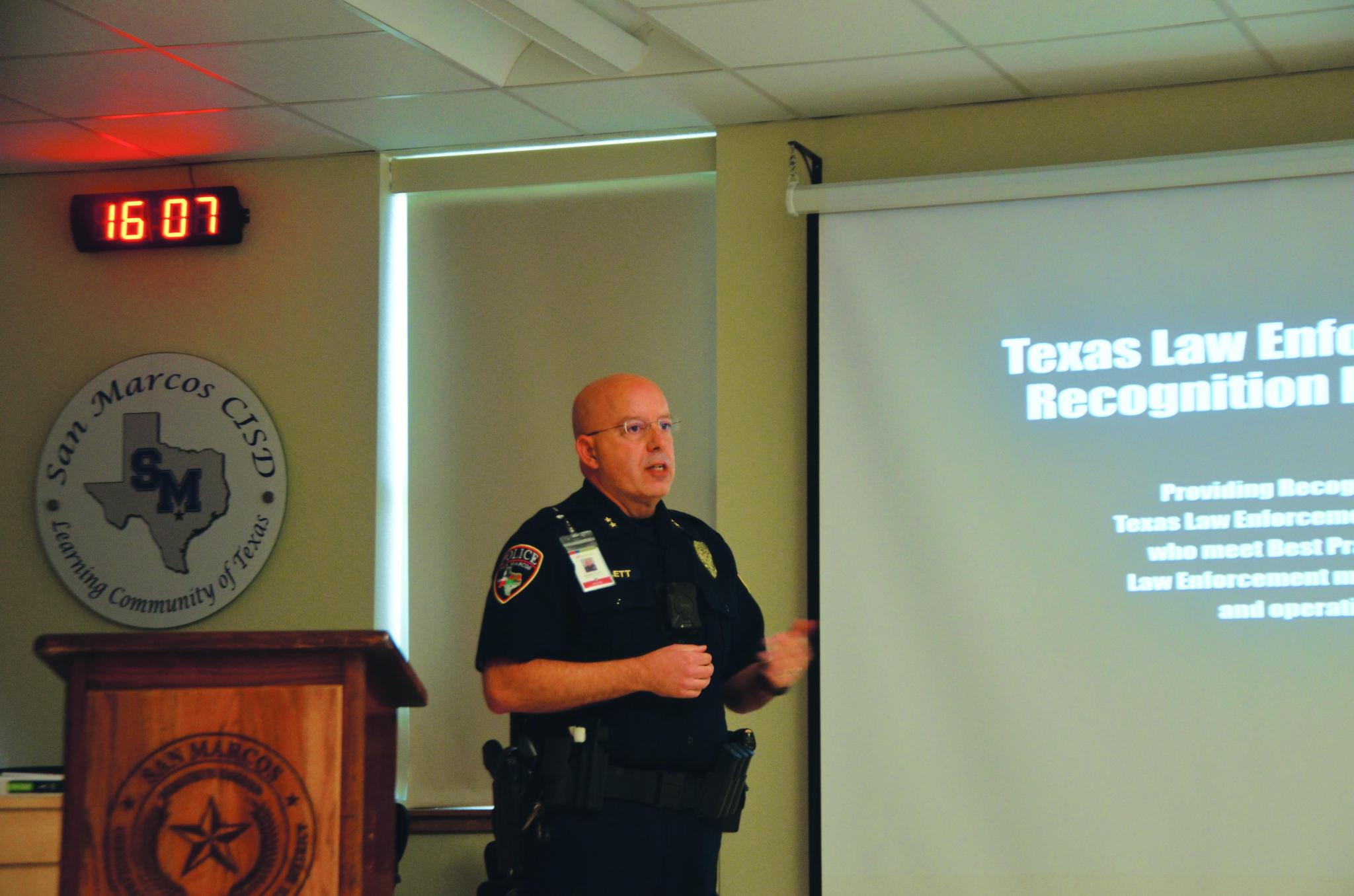
Interim chief and head of the San Marcos Police Department Bob Klett speaks at a San Marcos Area Chamber of Commerce public policy forum on Wednesday. Daily Record photo by Nick Castillo
Interim police chief discusses policy
Bob Klett says the No. 1 trait the San Marcos Police Department looks for in a potential officer during its hiring process is character.
Klett, SMPD’s newly named interim chief of police and head of the department, said the police department’s reputation hinges on hiring officers with excellent character.
“We ask questions based on character,” Klett said of SMPD’s hiring process. “So what are their morals? You know, one of the absolutes is you can’t lie, you can’t be a liar and do this job. It’s just too critical in everything we do when you have community trust. So character is something we really focus on.”
Klett spoke on a number of topics, including its hiring process, cite and release and active assault training during a San Marcos Area Chamber of Commerce Public Policy Forum at San Marcos High School on Wednesday.
Klett said SMPD currently has 108 officers who are split between patrol, criminal investigations, narcotics enforcement, traffic units, school resource officers and canine units. He said the department currently has seven openings.
Klett said when judging for character, SMPD looks for candidates with integrity and those whose values align with the department.
“We’re looking at things like integrity and we can ask a lot of open ended questions that dig at that,” Klett said. “We talk about how our community is different because we are a college community … We have applicants who come from the Central Texas area but we also had applicants from West Virginia, Kansas, Oklahoma, all across the United States. So when people come in, it’s like, okay, you’re bringing your values with you but what do you understand what the values are here?
“So we ask a lot of deep down questions. You know, sometimes we have them write a biography about themselves. And so we’ll dig into that biography. You said this but you avoided this issue, why is that? Tell us what you’re really thinking about this issue? What do you think about this population? What do you think about that? How do you deal with somebody who is different than you? How do you define service? How do you define, you know, those kind of things?”
Active assault training
Klett began a discussion on active assault training by discussing the Columbine High School shooting in 1999, where 12 students and one teacher was killed.
“There was a major issue of law enforcement response that happen out of (Columbine) that was scattered in time, where law enforcement officers surrounded the outside of the building and they’re waiting for SWAT to come in,” Klett said. “The whole time, they’re surrounding the building and there’s killing going on inside the school. And so what Columbine is, it’s a watershed for how law enforcement was trained.
“It was officers here in San Marcos, an officer from the City of San Marcos and officer from Hays County, that thought this can’t be the tactics that we use are sitting outside and waiting for SWAT.”
Klett said the Advanced Law Enforcement Rapid Response Training at Texas State University has helped SMPD officers and officers around the world learn how to respond to active-shooter events.
“When it comes to all your officers being trained properly, we’ve got probably some of the best trained officers in the world that are fresh on some of this stuff going on and how to respond,” Klett said.
He also discussed programs available for businesses, such as iloveyouguys.org, that train employees on how to deal with active assaults.
“(iloveyouguys.org has) a whole book you can download and it talks about teaching your employees on what to do if some kind of active shooter or activist assailant comes into your business or your church or your library or whatever else, and they come in to do things,” Klett said. “So there’s a whole program here you can download, all for free. And things you can do in your own businesses and churches or places where you gather to learn from.”
Cite and release
Klett also discussed SMPD’s use of cite and release, which is Texas program that allows peace officers to issue citations for Class C misdemeanors, as well as certain Class A and Class B misdemeanors, instead of making an arrest. Class A and B misdemeanors are eligible for a citation “if the person resides in the county where the offense occurred,” according to section 14.06 of Texas criminal code. Only seven offenses under the Class A and B misdemeanor sections are eligible for citations: possession of marijuana of up to 4 ounces, Class B criminal mischief of up to $750, Class B graffiti of up to $750, Class B theft of up to $750, Class B theft of up to $750 in services, providing contraband to a person in a correctional facility or driving with an invalid license.
SMPD has come under recent scrutiny after data compiled by Hays County showed that the department only used cite and release for 6.1% of eligible cases. According to SMPD’s its data shows different information than the county’s report.
“When it comes to cite and release, cite and release is an option. It’s not a preferred thing where it was told we should do this in lieu of arrest,” Klett said. “Arrest is not wrong, arrest is not right. Citation is not right, it’s not wrong. It’s an option ... It doesn’t mean we can’t make changes in that application.”











